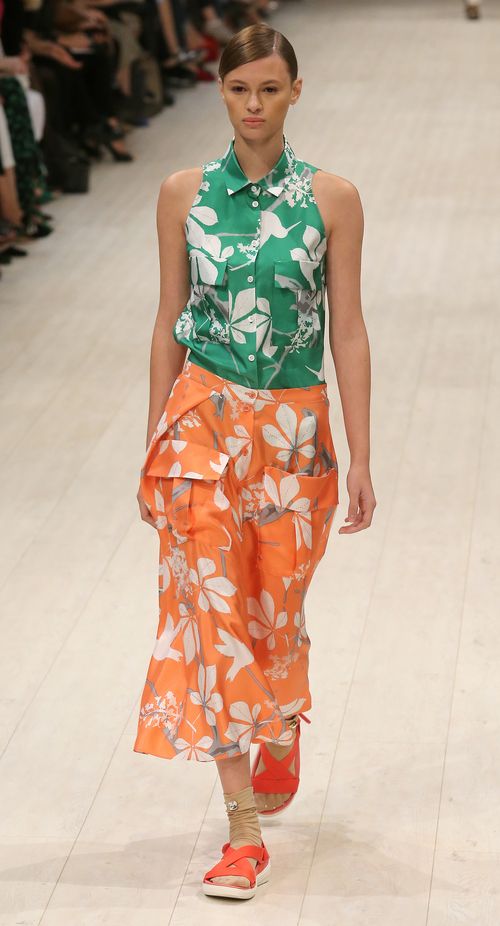Women who stop the war
Iryna DANYLEVSKA: “Anyone who still sees the Ukrainian Fashion Week as a festival has clearly stayed in 2000 mentally”
Dress shirts of “springlike” light-blue and pale green colors with chestnut prints, rethinking of the Greek mythology through trapezoidal silhouettes, a classic cut with geometric insets, marine mood with hints of Ivan Aivazovsky’s art, black-and-white multilayered images and an apocalyptic fashion art manifesto – all these were on display on the second day of the Ukrainian Fashion Week (UFW).
The UFW’s opening day saw a showing of the new spring/summer collection by Ukrainian designer Lilia Pustovit. As usual, its key components were dress shirts with added collar at the front and large pockets. Oftentimes, the dresses could be transformed into overalls, bringing the aesthetics of work clothes to the collection. Meanwhile, chestnut prints with fresh spring colors inspired visitors with new hope for rebirth after the long winter.
Another spring/summer collection was presented by Viktoria Gres, who took her inspiration from the Greek mythology. The new collection’s name is “Lysistrata,” that is, the name of the protagonist of Ancient Greek playwright Aristophanes’ comedy of the same name, who stopped the war. “While staying beside his woman, any man will seek only peace. Always. Fateful actions are in woman’s power. In the chaos of daily affairs, often unsuitable for a woman, it is very hard to remember one’s original purpose – to give love. However, it has to be done, as it is the only way to help in solving long-standing issues,” fashion designer Gres noted.

THE SPRINGTIME KYIV AND POSTER ART INSPIRED LILIA PUSTOVIT WHEN MAKING HER NEW SPRING/SUMMER COLLECTION
The event had its own fashion-performance as well. Mantis Religiosa, a tandem of young designers, presented its art manifesto “Intervention.” A futuristic collection, apocalyptic music, model in a synthetic robe who ate dollars – all this had to show visitors the likely result of urbanization and our conflict with nature.
“Anyone who still sees the UFW as a festival has clearly stayed in 2000 mentally,” co-founder and chairperson of the UFW’s organizing committee Iryna Danylevska commented for The Day. “Everyone is doing one’s job. People bake bread and make bricks... They do not go to the front, but we still appreciate them highly, because they do important work for the country. Here, a lot of people, thousands of people do no less important work for the country: provide jobs, support work of models, makeup artists, stylists, seamstresses, bring Ukrainian brands and Ukrainian clothing to foreigners, selling it in the West and paying taxes in this country.”

VISITORS OF THE UFW’S SECOND DAY WERE MOSTLY WOMEN – MUSICIANS, ACTRESSES, FASHION CRITICS, AND TV PRESENTERS. PICTURED: UKRAINIAN SINGER JAMALA
“The spring UFW coincided with the events that took place in Crimea. I said then that I would not go to any of the showings because I felt that my family was in danger, and it was,” Ukrainian singer Jamala told The Day. “I thought it would be just not right, even emotionally wrong, to come here, to put a dress on and smile at the camera while my mom was calling me and saying she was very concerned and scared. This time, I decided to support the UFW because I realized that we needed to support the Ukrainian culture industry. We have to go beyond telling everyone we are Ukrainian and wearing the Ukrainian flag on our clothes, etc., we have to prove its value. We have filmmaking, music, and fashion. If everyone does their share of work and we do it professionally, then these people out in eastern Ukraine who believe the central regions have it really bad will realize what they are missing. By coming today to the UFW, by making a new album and calling it Thank You, I support the Crimeans and eastern Ukrainians. I cannot grab an assault rifle and go to war, but I can make money with my talent and help people. The fashion designers are in a similar situation. I have noticed how Ukrainian fashion designers have increased their numbers and improved quality of their works just over the past six months. I really, really like clothes of their making, and 90 percent of my wardrobe comes from Ukrainian producers.”
Выпуск газеты №:
№64, (2014)Section
Time Out





